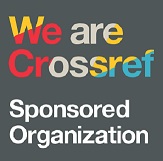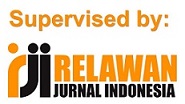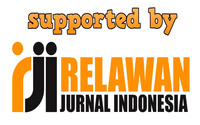EXPLORING EFL STUDENTS’ PROBLEMS IN LISTENING TO ENGLISH NEWS BROADCASTS
Abstract
Listening is central for language learning and for daily communication. However, in foreign language learning, students still encounter problems in understanding listening materials. This present study is aimed to reveal the students’ problems in listening English news broadcasts. The subjects of this study were two classrooms at the Department of English Language Education at an acknowledged university in Banda Aceh. The samples were made of 50 students in their third semester. This study employed a quantitative analysis approach. A close-ended questionnaire was used as the instruments in collecting the data. The findings showed that the difficulties faced by the students in listening to English news broadcast were mainly caused by unfamiliar topics, unfamiliar vocabulary, different accents, fast speech rate, unintelligible pronunciation, difficulty in inference making, excessively long passages, complicated grammatical structure, as well as complex ideas.
Keywords
Full Text:
PDFReferences
Akmal, S. (2013). A comparative analysis of task-based language teaching (TBLT) criteria in course books for upper intermediate English students. Jurnal Ilmiah Didaktika, 13(2), 351–372. https://doi.org/10.22373/jid.v13i2.483
Allen, R. Van. (1976). Language Experiences in Communication. Houghton: Houghton Mifflin School.
Becker, A. (2016). L2 Students’ Performance on Listening Comprehension Items Targeting Local and Global Information. Journal of English for Academic Purposes, 24, 1–13. https://doi.org/10.1016/j.jeap.2016.07.004
Bingol, M. A., Mart, C. T., Celik, B., & Yildiz, N. (2014). Listening Comprehension Difficulties Encountered by Students in Second Language Learning Class. Journal of Educational and Instructional Studies in the World, 4(4), 25–30. www.ijonte.org
Bloomfield, A., Wayland, S. C., Rhoades, E., Blodgett, A., Linck, J., & Ross, S. (2010). What Makes Listening Difficult? Factors Affecting Second Language Listening Comprehension. Journal of English Language Teaching, 9(6), 1–91. https://doi.org/10.21236/ADA550176
Brown, G., & Yule, G. (2013). Discourse Analysis. Cambridge University Press. https://doi.org/10.1017/CBO9780511805226
Buck, G. (2001). Assessing Listening. Cambridge University Press.
Burns, P. C., & Broman, B. L. (1975). The Language Arts in Childhood Education. Houghton: Third Edition. Houghton Mifflin Company.
Chen, A. hua. (2013). EFL listeners’ Strategy Development and Listening Problems: A Process-Based Study. Journal of Asia TEFL, 10(3), 81–101.
Creswell, J. W., & Poth, C. N. (2013). Qualitative Inquiry and Research Design. SAGE Publications, Inc.
Dörnyei, Z., & Taguchi, T. (2010). Questionnaires in Second Language Research: Construction, Administration, and Processing: Second edition. Routledge Taylor & Francis Group. https://doi.org/10.4324/9780203864739
Ebrahimi, Y. (2017). Discourse Analysis and the Development of English Listening Comprehension for Non-English Fields of Studies in Iran. Journal of Applied Linguistics and Language Research, 4(1), 166–177. http://www.jallr.com/index.php/ JALLR/article/view/505.
Emami, R., & Lashkarian, A. (2014). The Effect of Pre-Reading Activity on the Listening Comprehension of Intermediate EFL Learners. International Journal of Education and Research, 2(8), 111–122. https://www.ijern.com/journal/2014/August-2014/12.pdf.
Farrokhi, F., & Modarres, V. (2012). The Effects of two Pre-Task Activities on Improvement of Iranian EFL Learners’ Listening Comprehension. Theory and Practice in Language Studies, 2(1), 144–150. https://doi.org/10.4304/tpls.2.1.144-150
Fujita, R. (2017). Effects of Speech Rate and Background Noise on EFL Learners’ Listening Comprehension of Different Types Of Materials. Journal of Asia TEFL, 14(4), 638–653. https://doi.org/10.18823/asiatefl.2017.14.4.4.638
Gilakjani, Abbas Pourhosein, & Sabouri, N. B. (2016). Learners’ Listening Comprehension Difficulties in English Language Learning: A literature Review. English Language Teaching, 9(6), 123. https://doi.org/10.5539/elt.v9n6p123
Gilakjani, Abbas Pourhossein, & Ahmadi, M. R. (2011a). A study of Factors Affecting EFL Learners’ English Listening Comprehension and the Strategies for Improvement. Journal of Language Teaching and Research, 2(5). https://doi.org/10.4304/jltr.2.5.977-988
Gilakjani, Abbas Pourhossein, & Ahmadi, M. R. (2011b). A Study of Factors Affecting EFL Learners’ English Listening Comprehension and the Strategies for Improvement. Journal of Language Teaching and Research, 2(5). https://doi.org/10.4304/jltr.2.5.977-988
Hamouda, A. (2012). Listening Comprehension Problems - Voices from the Classroom. Language in India, 12(8). http://www.languageinindia.com/aug2012/v12i8aug2012.pdf.
Hamouda, A. (2013). An Investigation of Listening Comprehension Problems Encountered by Saudi Students in the EFL Listening Classroom. International Journal of Academic Research in Progressive Education and Development, 2(2), 113–155. https://www.semanticscholar.org/paper/An-Investigation-of-Listening-Comprehension-by-in-Hamouda/b811984d6e30068a62a970b1f75b2e701e0b159e.
Hasan, A. S. (2000). Learners’ Perceptions of Listening Comprehension Problems. Language, Culture and Curriculum, 13(2), 137–153. https://doi.org/10.1080/07908310008666595
Hayati, A. (2010). The Effect of Speech Rate on Listening Comprehension of EFL Learners. Creative Education, 01(02), 107–114. https://doi.org/10.4236/ce.2010.12016
Ilhan, B. (2018). Length in Listening Texts as a Single Determiner of Difficulty for Comprehension. Journal of Language and Linguistic Studies, 14(3), 336–346. www.jlls.org
Kazemi, S. A., & Zarei, L. (2015). The Efficacy of Topic Familiarity on Oral Presentation: Extensive Speaking Assessment Task of Iranian EFL Learners in TBLT. International Journal of Applied Linguistics and English Literature, 4(3), 93–97. https://doi.org/10.7575/aiac.ijalel.v.4n.3p.93
Kelly, G. (2006). How to Teach Pronunciation. New York: Pearson Education.
Kennedy, S., & Blanchet, J. (2014). Language Awareness and Perception of Connected Speech in a Second Language. Language Awareness, 23(1–2), 92–106. https://doi.org/10.1080/09658416.2013.863904
Lee, S. (2013). Korean University Students’ Listening Comprehension and Learning Effects of Connected Speech Processes in English. Korean Journal of Applied Linguistics, 29(3), 133. https://doi.org/10.17154/kjal.2013.09.29.3.133
Liang, D. (2015). Chinese Learners’ Pronunciation Problems and Listening Difficulties in English Connected Speech. Asian Social Science, 11(16), 98–106. https://doi.org/10.5539/ass.v11n16p98
Lingzhu, J., & Yuanyuan, Z. (2010). The Use of Authentic Materials in Teaching EFL Listening. Humanising Language Teaching Magazine for Teachers and Teacher Trainers, 12(4), 23–29. http://ejournal.unp.ac.id/index.php/isla/article/view/101275.
Liza, K., Adnan, A., & Ardi, H. (2013). English Department of UNP Students’ Ability in Listening to English News. Journal of English Language Teaching, 2(1), 152–159. https://doi.org/10.24036/JELT.V2I1.2601
Mahdavy, B. (2011). The Role of Topic Familiarity and Rhetorical Organization of Texts in L2 Incidental Vocabulary Acquisition. Procedia - Social and Behavioral Sciences, 29, 208–217. https://doi.org/10.1016/j.sbspro.2011.11.226
Mohamadi, Z. (2013). Determining the Difficulty Level of Listening Tasks. Theory and Practice in Language Studies, 3(6), 987–994. https://doi.org/10.4304/tpls.3.6.987-994
Morrison, B. (1989). Using News Broadcasts for Authentic Listening Comprehension. ELT Journal, 43(1), 14–18. https://academic.oup.com/eltj/article-abstract/43/1/14/376267?redirectedFrom=PDF.
Musa, N. N., & Fojkar, M. D. (2019). Correlation Between Students’ English Listening Skills, Vocabulary Skills and Out-Of-School Listening Exposure. New Educational Review, 55(1), 42–53. https://doi.org/10.15804/tner.2019.55.1.03
Namaziandost, E., Neisi, L., Mahdavirad, F., & Nasri, M. (2019). The Relationship between Listening Comprehension Problems and Strategy Usage among Advance EFL Learners. Cogent Psychology, 6(1). https://doi.org/10.1080/23311908.2019.1691338
Palinkas, L. A., Horwitz, S. M., Green, C. A., Wisdom, J. P., Duan, N., & Hoagwood, K. (2015). Purposeful Sampling for Qualitative Data Collection and Analysis in mixed Method Implementation Research. Administration and Policy in Mental Health and Mental Health Services Research, 42(5), 533–544. https://doi.org/10.1007/s10488-013-0528-y
Rao, P. S. (2019). The Effective Use of Authentic Materials in the English Language Classrooms. Shanlax International Journal of Arts, Science and Humanities, 7(1), 1–8. https://doi.org/10.34293/sijash.v7i1.556
Rost, M. (2011). Teaching and Researching Listening. New York: Pearson Education Limited.
Samian, S. H., & Dastjerdi, H. V. (2012). The Relationship between Prior Knowledge and EFL Learners’ Listening Comprehension: Cultural Knowledge in Focus. Mediterranean Journal of Social Sciences, 3(1), 361–370. https://doi.org/10.5901/mjss.2012.03.01.361
Saraswaty, D. R. (2018). Learners’ Difficulties & Strategies in Listening Comprehension. English Community Journal, 2(1), 139. https://doi.org/10.32502/ecj.v2i1.1003
Tsagari, D., & Banerjee, J. (2016). Handbook of Second Language Assessment. De Gruyter. https://doi.org/10.1515/9781614513827
Underwood, M. (1989). Teaching Listening. New York: Pearson Education Limited.
Ur, P. (2012). A Course in English Language Teaching (2nd ed.). Cambridge: Cambridge University Press.
Usó-Juan, E., & Martínez-Flor, A. (2006). Current Trends in the Development and Teaching of the four Language Skills (Vol. 29). Mouton de Gruyter. https://doi.org/10.1515/9783110197778
Walizer, M. H., & Wienir, P. L. (1978). Research Methods and Analysis : searching for relationships. ew York: Harper and Row.
Walker, N. (2014). Listening: the most Difficult Skill to Teach. Encuentro, 23, 167–175. https://core.ac.uk/download/pdf/58911108.pdf.
West, R., & Turner, L. (2010). Understanding Interpersonal Communication: Making Choices in Changing Times (2nd ed.). New York: Cengage Learning, Inc.
Widdowson, H. G. (2003). Defining Issues in English Language Teaching. Oxford: Oxford University Press.
Willis, J. (1981). Teaching English Through English: A Course in Classroom Language and Techniques (Handbooks for Language Teachers). London: Longman.
Wong, V., Kwok, P., & Choi, N. (1995). The Use of Authentic Materials at Tertiary Level. ELT Journal, 49(4), 318–322. https://doi.org/10.1093/elt/49.4.318
Yamane, S., & Yamane, K. (2012). ABC World News 14. Kinseido. https://www.kansai-u.ac.jp/fl/publication/pdf_department/11/07yamane.pdf.
Yang, X., Jiang, M., & Zhao, Y. (2017). Effects of Noise on English Listening Comprehension among Chinese College Students with Different Learning Styles. Frontiers in Psychology, 8(10). https://doi.org/10.3389/fpsyg.2017.01764
Yoestara, M., & Putri, Z. (2019). PODCAST: An Alternative Way to Improve EFL Students’ Listening and Speaking Performance. Englisia Journal, 6(1), 15. https://doi.org/10.22373/ej.v6i1.3805
Zhafarghandi, A. M., Barekat, B., & Homaei, S. (2014). Advances in Language and Literary Studies: A Survey of Iranian EFL Teachers’ and Learners’ Perceptions toward Authentic Listening Materials at University Level. Advances in Language and Literary Studies, 5(4), 184–197. https://doi.org/10.7575/aiac.alls.v.5n.4p.184
DOI: https://doi.org/10.30743/ll.v4i2.2940
Refbacks
- There are currently no refbacks.
Fakultas Sastra
Universitas Islam Sumatera Utara (UISU), Medan
Jl. Sisingamangaraja Teladan Medan 20217
Telp. (061) 7869911, e-mail: language_literacy@sastra.uisu.ac.id









